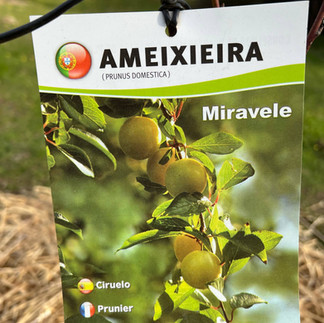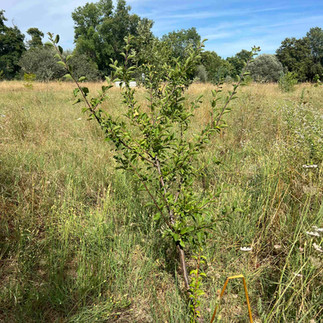Prunus domestica subsp. syriaca (Mirabelle Plum)
- Herman Kraut

- Jul 21
- 4 min read
Updated: Jul 31
Common Name: Mirabelle Plum
Scientific Name: Prunus domestica subsp. syriaca
Plant Family: Rosaceae
Lifecycle: Perennial
A golden gem of French orchards, Prunus domestica subsp. syriaca (Mirabelle plum) is renowned for its delicate sweetness, small golden fruits, and surprising drought tolerance. Growing Mirabelle plum in Zone 8a is a rewarding venture, especially in Mediterranean-style climates where strategic planting makes all the difference.
For in-depth guides and curated tools, be sure to check out our Recommended Books & Resources below.
Plant Profile
Characteristic | Information |
Climate Suitability | USDA Zones 5–9; Köppen Csa/Csb |
Sun / Shade Needs | Full sun (minimum 6 hours/day) |
Watering Needs | Low to moderate; drought-tolerant once established |
Soil Preferences | Well-draining loam; pH 6.0–7.5 preferred |
Spacing & Height | 4–5 m spacing; grows 3–6 m tall (10–20 ft) |
Propagation Method(s) | Grafting preferred; seed-grown trees show variability |
Planting Timeline | Dormant season (late winter to early spring) |
Companion Plants | Comfrey, garlic, clover, borage |
Edible / Medicinal / Ecological Uses | Fresh eating, preserves, fermentation; attracts pollinators |
Pest / Disease Considerations | Susceptible to aphids, brown rot, canker; prune for airflow |
Pruning / Harvest Notes | Prune mid to late winter; harvest mid-summer when golden fruits drop easily |
Quick Plant Reference
Care Level: Moderate
Optimal Sunlight: Full sun
Water Needs: Low to moderate
Mature Size: 4–6 m (13–20 ft) height & 3–5 m (10–16 ft) spread
Soil Type: Loamy, well-drained, neutral to slightly acidic
Humidity: Medium
Toxicity: Seeds contain amygdalin; do not consume pits
Beneficial Pollinators: Bees, hoverflies, butterflies
Health Benefits: Rich in vitamin C, fiber, and antioxidants
Chilling Hours: 700–1,000 hours (0–7 °C / 32–45 °F)
Pollination Requirements: Partially self-fertile; higher yields with pollinator variety nearby
Our Prunus domestica subsp. syriaca Application @ Tough Kraut
We planted our Mirabelle plum tree on April 22, 2022, at the northwest edge of our food forest, right above an underground water line between our stone well and the neighbor’s water mine. Despite almost no direct watering, the tree adapted beautifully and gifted us two golden fruits in its third year. It’s a quiet reminder that resilience is often rooted underground.
Step-by-Step Growing Guide
Note: If your Mirabelle seems slow to fruit or is struggling in dry soil, see the Field Notes section below for real-world troubleshooting.
1. Choose the Right Site
Pick a sunny location with good air circulation. Our Mirabelle flourished at the northwestern edge of the food forest with access to subsurface water.
2. Prepare the Soil
Loosen the soil deeply and mix in organic compost. Mirabelle prefers loamy, well-drained soils with moderate fertility and slight acidity.
3. Plant the Tree/Plant
Plant during dormancy (late winter to early spring). Keep the graft union slightly above soil level and mulch generously without touching the trunk.
4. Water Consistently
Water weekly during the first year. Mature trees can tolerate drought surprisingly well—ours receives no supplemental watering and still fruits.
5. Ensure Proper Pollination
While Mirabelle plums are often self-fertile, planting near another compatible Prunus species boosts yield and reduces drop.
6. Prune Annually
Shape in late winter to maintain airflow and sunlight penetration. Remove crossing or deadwood branches to reduce disease pressure.
7. Manage Pests and Diseases
Watch for brown rot and aphids. Thin fruit, keep mulch fresh, and apply neem or insecticidal soap as needed.
8. Harvest and Store
Fruits ripen mid- to late summer. They should detach with a gentle tug and can be eaten fresh, preserved, or fermented into traditional Mirabelle schnapps.
9. Note
If you're seeing lush leaves but no fruit, check for overfertilization or lack of pollinators. Too much shade or overwatering can also delay production.
Kraut Crew Insight
Our Mirabelle plum’s success with no irrigation and minimal intervention reminded us that good planning beats constant babysitting. Site it right, then let the roots do the work.
Photos
Herman’s Tough Kraut Field Notes: Solving Mirabelle Plum Cultivation Challenges
We’ve learned the hard way that low-maintenance doesn’t mean no management. Here's our quick FAQ for Prunus domestica subsp. syriaca growers trying to troubleshoot fruiting, watering, and other common head-scratchers.
Q: Why is my Mirabelle not fruiting after 2–3 years?
A: It’s normal for Mirabelle to take 3–5 years to fruit, especially when grown from seed. Ensure it receives full sun and hasn’t been overfed with nitrogen-heavy fertilizer.
Q: Can Mirabelle plum survive without watering?
A: Yes, once established. Ours thrived above a buried water line with virtually no surface watering—choose your site well.
Q: How do I know when Mirabelle plums are ripe?
A: Ripe fruit turns rich golden-yellow and drops when nudged. Harvest over a few days, not all at once.
Q: What pests affect Mirabelle in Mediterranean climates?
A: Aphids and brown rot are common. Use sticky traps early in the season, prune for airflow, and consider planting garlic or nasturtium nearby.
Q: Do I need a pollinator tree?
A: Not strictly, but yes if you want better fruit set. Companion varieties like Prunus cerasifera or Prunus domestica improve yield.
Recommended Books & Resources
Books
The Backyard Orchardist by Stella Otto
A no-nonsense, beginner-friendly guide to growing fruit trees organically.
Grow a Little Fruit Tree by Ann Ralph
Smart advice on keeping fruit trees small, productive, and manageable.
Fruit Trees for Every Garden by Orin Martin & Manjula Martin
Excellent reference for understanding small-scale orchard design and pollination dynamics.
Resources
Dave’s Garden
Real gardeners sharing real cultivar experiences, pest hacks, and zone tips.
Tough Kraut Resources
Our handpicked collection of essential tools, books, pantry picks, and composting gear to build resilience from soil to shelf.
Entry last updated: 2025-07-31
This post is part of the Tough Kraut Plant Library, documenting what really grows on our off-grid homestead in Central Portugal.











Comments